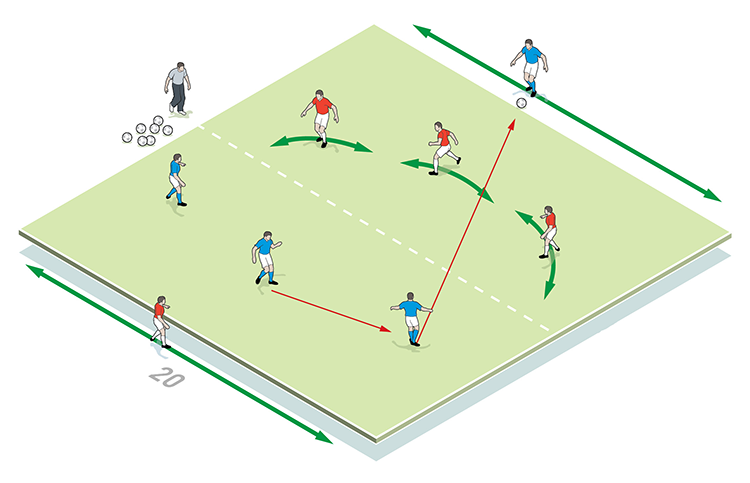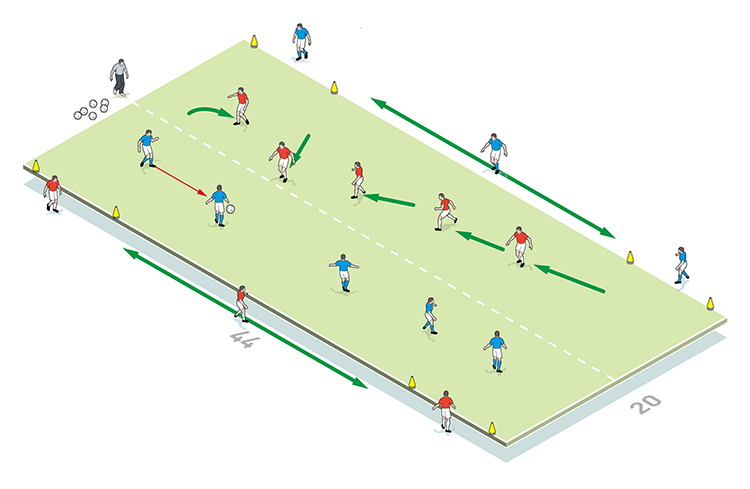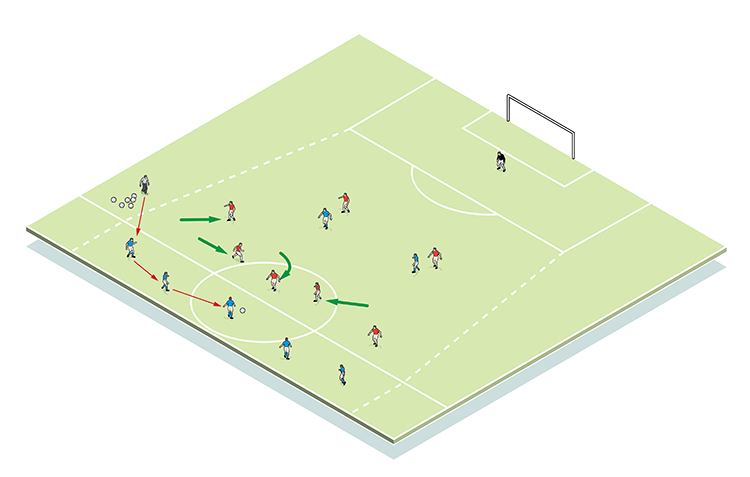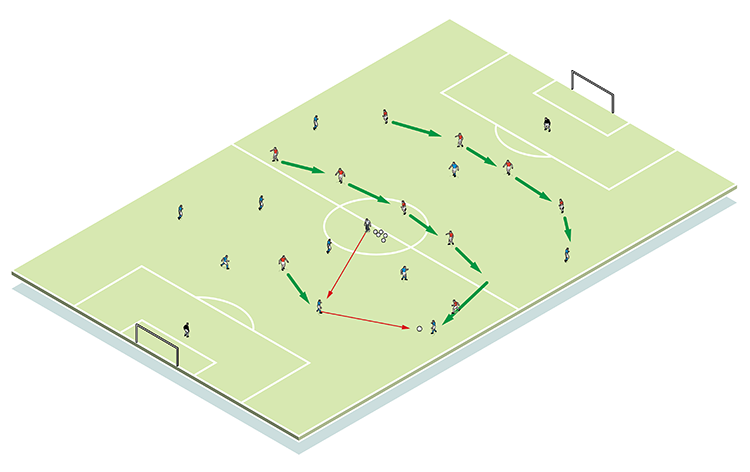This session offers a deep tactical insight into how defensive solidity can be attained through the use of a knowledgeable, tight and hard-working midfield unit.

| Area | Up to a half-pitch plus 20 yards |
| Equipment | Balls, cones, goals |
| No. of Players | Up to 11v11 |
| Session Time | 10mins per practice |
As managers and coaches, it can be easy to expect the bulk of defending to be done by our back four, but very often key defensive duties can and should be undertaken by midfielders, with an exposed defence representing an emergency situation whereby the midfield have perhaps failed in their duties.
This session therefore offers a deep tactical insight into how defensive solidity can be attained through the use of a knowledgeable, tight and hard-working midfield unit.
In setting up a barrier or organised line of defence, it supports and protects the defenders and should reduce spaces through which opposition players may comfortably pass or move forward with the ball.
What follows is a variety of practices that are designed to increase the understanding of midfielders – once behind the ball – in their defending functions, as well as looking at their relationships with forward and back players.
What do I get the players to do?
2v1 practice (1)
We set up as shown – blues passing the ball back and forth, always below head height, and evading the attention of the red defender, who must stay in his area. If an interception is made, the server restarts. After 30 seconds, we count how many passes and interceptions are made.
In order to have the best chance of intercepting, the red defender must anticipate passes, be in a defensive stance that helps him to move sideways quickly to win the ball, and reach, stretch or disrupt the intended pass.
1

3v3 plus targets (2/3)
Now in a 20x20-yard area, we set up 3v3 plus a target player at each end. Each team of three must stay in its own area and attempt to pass through to the target man. On receiving a pass the target player feeds into the previous defending unit.
Here, we’re looking for defending teams to slide across with the path of the ball, with defensive stances showing players are able to react quickly to an attempted pass. The nearest defender must press the ball as closely as possible (whilst remaining in his half), with defenders monitoring distances and angles between each other as well as checking the position of the target man behind.
2

3

5v5 plus targets (4)
We now move to 5v5 plus two targets. Teams score by the coach’s chosen method - passing the ball through goals A or B, or passing into the target man.
Again, we’re looking for players to slide as a group, press using the nearest defender, assess distances and angles, as well as being ready to regroup when the opposition takes control of the ball.
4

7v7 plus keeper and targets (5)
Now the practice area funnels back to the corners of the penalty box, as shown. The server feeds blue attackers who retain possession until being able to feed strikers. Attackers take the ball on 2v2 in the advanced area and attempt to score past the keeper. Should reds steal possession, the game resets, or we can add target goals at the bottom to be reached within four passes.
On passes through to strikers, the midfielders can recover towards the goal, with the two nearest pressing the receiving striker from the front. Centre-backs must prevent strikers from turning.
5

In the progression, we extend to 9v8 plus a keeper (6), removing the funnel lines and using 15x15-yard target areas. Reds spread out and play from the back, building until being able to feed into the target man. On restart, the ball can be fed directly into the other team, or target players can play between themselves (7). We finish with an 11v11 where the principles learnt can be put into practice (8).
6

7

8

What are the key things to look out for?
We want to see all players developing an understanding of the defensive roles and responsibilities for midfield players, both ‘forwards’ and ‘backwards’ in terms of their distances and angles, plus their relationships with each other, the ball and those other defending units.
They must also develop the ability to shift body weight quickly in a low defending stance, building quick recognition and reactions to block passes and recover towards the ball or goal.
Mentally, players must concentrate and focus on the task in hand, developing a ‘unit’ mentality with team mates in midfield, all the time building an awareness and understanding of the roles of defenders both ahead of and behind them.
Editor's Picks
Attacking transitions
Deep runs in the final third
Using the goalkeeper in build-up play
Intensive boxes drill with goals
Penetrating the final third
Creating and finishing
My philosophy
Pressing initiation
Compact team movement
Coaches' Testimonials

Alan Pardew

Arsène Wenger

Brendan Rodgers

Carlos Carvalhal

José Mourinho

Jürgen Klopp

Pep Guardiola

Roy Hodgson

Sir Alex Ferguson

Steven Gerrard
Coaches' Testimonials

Gerald Kearney, Downtown Las Vegas Soccer Club

Paul Butler, Florida, USA

Rick Shields, Springboro, USA

Tony Green, Pierrefonds Titans, Quebec, Canada
Join the world's leading coaches and managers and discover for yourself one of the best kept secrets in coaching. No other training tool on the planet is written or read by the calibre of names you’ll find in Elite Soccer.
In a recent survey 92% of subscribers said Elite Soccer makes them more confident, 89% said it makes them a more effective coach and 91% said it makes them more inspired.
Get Monthly Inspiration
All the latest techniques and approaches
Since 2010 Elite Soccer has given subscribers exclusive insight into the training ground practices of the world’s best coaches. Published in partnership with the League Managers Association we have unparalleled access to the leading lights in the English leagues, as well as a host of international managers.
Elite Soccer exclusively features sessions written by the coaches themselves. There are no observed sessions and no sessions “in the style of”, just first-hand advice delivered direct to you from the coach.








